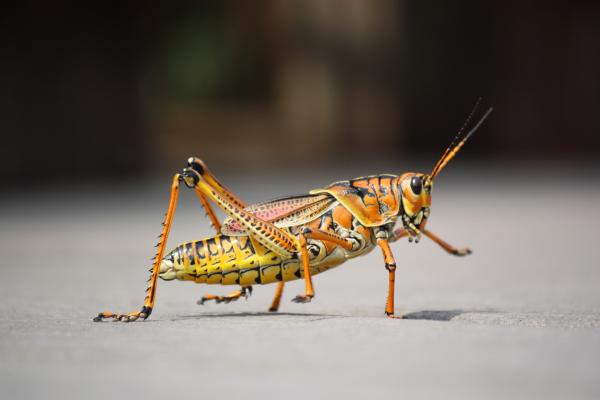How Long Do Grasshoppers Live?


The average lifespan of a grasshopper will depend on species, with some only living a few weeks and others up to 6 months. For the individual grasshopper, factors such as food availability and climate will influence their longevity. Grasshoppers are insects the order Orthoptera, specifically of the suborder Caelifera. They are herbivorous and survive by chewing plant material. They have an interesting lifecycle when compared to other insects. Unlike butterflies, beetles and many other insect species, they go through a partial metamorphosis known as hemimetabolism. This means they appear very similar to their adult forms after hatching.
At AnimalWised, we learn more about this lifecycle to find out how long do grasshoppers live? We look at their general life expectancy, as well as the lifespans of example grasshopper species.
Life cycle of a grasshopper
The life cycle of a grasshopper consists of several distinct stages, each with specific characteristics and functions. As stated in the introduction, this insect species experiences a type of development known as hemimetabolism. After they hatch from their eggs, some species are completely different in their juvenile form when compared to their adult stage. For example, are caterpillars are very different to adult butterflies. For the grasshopper, the lfe cycle stages are as follows:
- Egg: the life cycle of a grasshopper begins with the female laying eggs in the ground, bark of a tree or other suitable places. The length of the incubation period varies depending on the species and environmental conditions, but can range from a few weeks to several months.
- Nymph: after hatching, the nymph emerges. This is an immature version of the adult grasshopper. During the nymph stage, the insect resembles an adult grasshopper, but lacks fully developed wings. It undergoes several molts to grow and develop. These molts are essential to allow the grasshopper to increase in size. Depending on the species and other factors, the nymph stage will last a few weeks or months.
- Adult: once the nymph has completed its development, it becomes an adult grasshopper. During this stage, the wings are fully developed, allowing the grasshopper to move beyond limited distances. Adult grasshoppers focus on reproduction and their longevity can vary significantly between species.
The breeding process involves interaction between males and females, often including behavioral displays and specific calls. After copulation, the female lays her eggs, completing the cycle and restarting it for the next generation.
The total length of a grasshopper's lifespan can vary considerably depending on the species, environmental conditions and resource availability. While some grasshoppers can complete their life cycle in a few weeks, others may require several months to go through all the stages. This adaptive life cycle allows them to survive and reproduce in a variety of environments.
Learn more about adult grasshoppers with our article on how many legs do grasshoppers have?

How long does a grasshopper live in the wild?
The lifespan of a grasshopper in the wild can vary significantly depending on the species and environmental conditions. Many common grasshoppers have a relatively short adult lifespan, which can range from a few weeks to up to around a couple of months. Short-lived grasshoppers exist, with adult individuals living only a few weeks. This is the case with the slender ground-hopper (Tetrix subulata).
Other grasshoppers may have a longer lifespan as an adult. For example, the migratory locust (Locusta migratoria) is known to have one of the longest lifespans of all grasshoppers. This is the grasshopper with one of the greatest population distributions, inhabiting various parts of Africa, Asia and further afield.
Below are some example species of grasshoppers and their average lifespans:
- Common field grasshopper (Chorthippus brunneus): 6-8 weeks as adults.
- Migratory locust (Locusta migratoria): 3-5 months as adults.
- Red-legged grasshopper (Melanoplus femurrubrum): 2-3 months as adults.
- Differential grasshopper (Melanoplus differentialis): 2-3 months as adults.
- Northern green-striped grasshopper (Chortophaga viridifasciata): 1-2 months as adults.
Some grasshopper species are known to make long-distance migrations. In these cases, longevity may be influenced by the length of the trip and the availability of resources in different locations.
Environmental conditions that can affect the longevity of grasshoppers in the wild include food availability, climate, and the presence of predators. It is important to note that these are generalizations and that the lifespan of a grasshopper can vary even within the same species depending on the specific conditions of the environment in which it is found. In domestic environments, the conditions can be better controlled, so individuals may live longer.

How long can a grasshopper live in captivity?
The lifespan of a grasshopper in captivity can also vary depending on several factors, including the species and environmental conditions. How its care is managed is particularly important. In a controlled environment, some grasshoppers may live longer than in the wild due to the mitigation of factors such as predators, extreme weather conditions and other risks associated with the wild environment.
In general, grasshoppers kept at home can live for several weeks or even months. A long grasshopper lifespan is best ensured if suitable housing, a balanced diet and optimal care conditions are provided. The length of their life may also depend on individual health and the age at which they were acquired.
We must take into account the specific needs of the grasshopper species you have at home, as different species may have different care requirements. Providing an enriched environment, proper feeding and careful handling will contribute to the health and longevity of grasshoppers in captivity.
It is recommended not to have grasshoppers as pets, since they are extremely sensitive insects. Some may keep them as food for other animals, especially reptiles such as snakes and lizards. If we do so, we must take all precautions possible. We will need to maintain an adequate temperature, humidity and light according to the needs of the species. In addition, if you have a grasshopper at home, you should provide it with a balanced and appropriate diet for the species, something you can find in our article on what does a grasshopper eat?
Excessive handling of grasshoppers should be avoided and adequate enclosures provided to minimize stress. Additionally, you should watch for signs of illness, changes in behavior or dietary problems. For all these reasons, we state that the best way to enjoy these animals is to observe them in their natural habitat and without disturbing them.
Now you know how long grasshoppers live in the wild and in captivity, you may want to know more with our article on do grasshoppers bite?

If you want to read similar articles to How Long Do Grasshoppers Live?, we recommend you visit our Facts about the animal kingdom category.
- Bidau, C. J. (2014). Patterns in Orthoptera biodiversity. I. Adaptations in ecological and evolutionary contexts. Journal of Insect Biodiversity, 2(20), 1-39.
- Donelson, N. C., Smith, A. R., & Van Staaden, M. J. (2008). Variation in adult longevity in a polymorphic grasshopper species. Journal of Orthoptera Research, 17(2), 279-282.
- Mariottini, Y., Wysiecki, M. L. D., & Lange, C. E. (2011). Longevity and fecundity of Dichroplus maculipennis (Orthoptera, Acrididae) at non-outbreaking and outbreaking situations. Revista Brasileira de Entomologia, 55, 435-438.
- Rentz, D. C. (1978). Orthoptera. Biogeography and Ecology of Southern Africa, 733-746.








